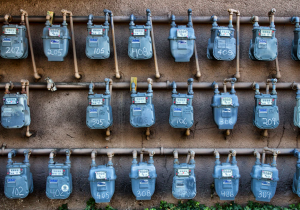The Days of Reckoning: Who will Pay the already existing $35 – $40 billion customer COVID-19 Utility debt?
By Carl LaVerghetta, MEA Senior Policy Advisor
There is a rather ominous reality emerging in the public utility domain. Utilities’ repayment plans may help people who still have jobs, but too many people are jobless right now and they are sinking deeper into that debt they may never pay off. Proposals to pass the burden to utility customers merely adds to their debt, but forgiveness creates a taxpayer debt, and if we can do that for businesses, surely we can do it for working class people? Certainly, an interesting question. However, this debt forgiveness must be done state by state, because public utilities and their rates are set by states.
Utilities have reported mixed cost impacts related to COVID-19. Some operating costs, such as safety and medical protective equipment for employees, have gone up. Other costs, such as for fuel, have gone down for some utilities. Lost revenue associated with disconnection moratoria represent a significant additional cost for utilities. Utilities typically recover all their costs through revenue (i.e., electricity sales). Total electricity use (and utility sales) has declined since COVID-19 began impacting the United States, though different regions of the country have been affected differently. Many observers expect electricity use to remain below 2019 well into the spring and summer of 2021. There are some analysts at IBIS World and Wood MacKenzie that expect low electricity use to persist beyond that. Utilities have different options to address the difference between their costs and revenue (i.e., their revenue shortfall). Across America, smaller utilities are dealing with serious balance sheet shortfalls. Smaller utilities generally do not have the cash reserves of the larger investor-owned utilities with publicly-owned utilities, and electric coops generally setting rates based on costs without typically having the recourse to submit rate cases to state regulatory commissions to collect revenue
The National Rural Electric Cooperative Association (NRECA) presented testimony to Congress and commented that the coronavirus pandemic will cause a $10 billion revenue shortfall in 2021. The NRECA also projects a 5% decline in electricity sales revenue through 2021. Electricity Cooperatives, especially those serving rural areas of the country, are dealing with increasing financial pressures.
In utility parlance, there is something called the “cost causality” principle of utility regulation assigns costs to those who cause them for the utility and “to the extent possible,” the first choice for covering the debt is going to be direct assignment or the transfer of debt and all associated rights and obligations from a creditor to a third party. However, the individual customer’s mounting debt makes it unlikely they will be able to pay off that debt. If no other viable options are available, there will have to be federal assistance plans, which means the existing debt will be covered by someone else through some mix of options.
Keep in mind that regulated electric and gas utilities are expected to return to a heavier reliance on debt to raise capital. A utility revenue bond, or “essential service bond,” is used to fund capital projects in areas considered essential to public services, these services can include hospitals, water and waste treatment facilities and, most certainly, improvements to local transmission infrastructure and the electrical grid. These services generate revenue through customer fees which provide cash flows that can cover debt service obligations. The obvious fly in the ointment, especially during the COVID-19 pandemic is that even with the serious disruptions in ratepayer payment revenue streams, the utilities still must go into the bond markets for essential capital for new projects and O&M. Credit rating agencies are tasked to determine the creditworthiness of the borrowing agent (the utility) for the purpose of providing investors with the information related to these entities meeting their obligations. If utilities are suffering cash flow issues because of moratoriums and bill payment forgiveness initiatives, the cost of borrowing escalates; just forcing public utilities to defray needed capital improvements or asking for rate increases to cover the cost increase or, perhaps, both.
One option is state-issued bonds. Secured by the state, their low risk profile typically attracts investors. The capital raised from their sale could pay off the debt. But because the cost of interest on government bonds would be paid by taxpayers, this option faces significant political opposition. An alternative is imposing the burden on the utility. For an investor-owned utility, that transfers the debt to its investor-shareholders. But that would threaten the investor-appeal of a utility, which could lead to a compromise of its financial stability and ability to deliver services to its customers.
Municipal utilities and even cooperatives are essentially owned by their customers and have no shareholders. There are no investors to shift the debt burden to, and shifting it to customers could create citizen and member opposition similar to the voter opposition created by the state-issued bond solution. The utility’s debt burden could also be spread among all ratepayers. Most state regulators would be reluctant to approve this solution because of the upward pressure it would put on rates, especially because it would require a public proceeding in which ratepayer advocates and other stakeholders might block regulatory approval by making it politically controversial.
Regulators have, increasingly, been interested in securitization of various ratepayer obligations, which limits the impact on rates and allows the debt to be recovered over time. Securitization is the conversion of an asset, notably a loan, into marketable securities, typically for the purpose of raising cash by selling them to other investors. Naturally, if the utility is suffering cash flow problems and has had to neglect needed infrastructure improvements, securitization becomes a more problematic undertaking.
Keep in mind that the utility creates and sells AAA-rated bonds. These instruments are secured by ratepayers and the goal is to obtain favorable interest rates to limit rate impacts. With the capital from bondholders attracted by the low risk offering, the utility could pay off customers’ COVID debt and spread it over time to limit rate impacts without involving shareholders or threatening utility balance sheets.
Financial strategies like securitization are gaining some traction because they spread the cost across all ratepayers and over time. But regulators would have to decide how to implement those strategies because the law in Maryland and many other states is not specific about how that is to be done and regulators might be reluctant to take that situation on. Another solution that is beginning to create some discussion is the “private equity” buyout of a public utility. There has even been some discussion of “leveraged buyouts” (LBO) of struggling public utilities, especially if the current environment continues to worsen. A leveraged buyout is the acquisition of another company using a significant amount of borrowed money (bonds or loans) to meet the cost of acquisition. The once-in-a-century pandemic-induced economic downturn has disrupted private equity’s usual business strategies but has opened new opportunities at the same time. Right now, private equity firms have more cash in reserve than ever, $1.5 trillion, and they are seeking ways to put that money to work.
As the pandemic continues, private equity firms are looking at utilities, especially if the particular private equity group of investors or equity partners are already in that energy space. Of course, regulators must review, analyze any acquisition of this nature. The acquisition of a public utility would be scrutinized by a state’s public utility commissioners. The primary regulatory concern would be whether the acquisition was aligned with the public interest, i.e. to provide reasonable cost of capital, a standard of reliability equal to or exceeding the current standard through the maintenance of the utility’s electricity transmission infrastructure. One area of increased activity is the acquisition of microgrids by both private equity firms and by multinational oil and gas corporations.
Leverage buyout firms like KKR & Co, Inc., Credit Suisse GP, AG, and the Blackstone Group are also actively scrutinizing the entire business landscape, including the struggling and relatively inexpensive energy sector and that interest extends to both private and struggling public utility companies. In Maryland, the current financial health and stability of in-state electric utilities does not require any of these kinds of actions, but the real issue is the ongoing pandemic and the medium term impact it will have on the financial health and stability of Maryland’s public utilities and privately held utilities. The two questions sitting in the back of people’s mind is: What will happen if the pandemic disruptions continue well into the summer of 2021? Even with the increased availability of a COVID -19 vaccine, the current conditions will not simply vanish like smoke in the wind. Consequently, will public utilities and privately owned and operated utilities be able to keep the electricity transmission infrastructure reliable and resilient?
Across the United States, public utilities, independent investor-owned utilities, and electric cooperatives are reviewing existing policies concerning disconnection of service, reconnection of service, payment arrangements, and suspension of other fees or charges, and these entities will update their existing policies as appropriate and necessary to assist vulnerable individuals and households to maintain essential services during the economic recovery. As the impact of the pandemic continues to evolve, many utilities are experiencing conditions often associated with any serious economic downturn, including, but not limited to, financial market volatility and erosion of market value, deteriorating credit, liquidity concerns, further increases in government intervention, increasing unemployment, layoffs and furloughs, and other kinds of restructuring activities. PJM has commented that lower demand for energy during the COVID-19 pandemic, along with low prices for natural gas and strong power generation from renewable energy resources, has brought unprecedented low prices for electricity in multiple U.S. markets and Exelon/Constellation noted that the pandemic has impacted both the “Real-Time” (five minutes) energy market and the “day-ahead” (one day forward) market. Ultimately, however, no one can predict with any high degree of certainty the outcomes from the increasingly prolonged disruptions of the U.S. economy.
So, maybe the best way to predict outcomes for the utilities during this pandemic is to listen to Warren Buffett when he was asked about his impressive expansion of Berkshire Hathaway Energy. Mr. Buffett replied, “The energy business is not a way to get real rich, but it is a way to stay rich.” The not so subtle meaning behind the ‘Oracle of Omaha’s’ words is that, even with all of the cash flow difficulties being experienced by electric utilities, those debts will, eventually, be socialized.



 1-888-373-7888
1-888-373-7888 233733
233733